 A friend of ours has recently decided to stop eating meat. That sounds simple, but if you’ve always eaten meat, it’s not as simple as it sounds. If you’ve never really thought too hard about what you eat, it could be a complete shock to the system. Our friend is definitely finding that to be the case.
A friend of ours has recently decided to stop eating meat. That sounds simple, but if you’ve always eaten meat, it’s not as simple as it sounds. If you’ve never really thought too hard about what you eat, it could be a complete shock to the system. Our friend is definitely finding that to be the case.
Knowing that I am vegetarian, he has picked my brain a few times, and it has made me think that it could be an interesting post for anyone making the same change to their diet.
Removing meat means losing vital nutrients in your diet, all of which are easily replaceable as long as you know what you’re doing. The main one is obviously protein, but also vitamin B12, vitamin D, zinc, iron, calcium and omega 3 fatty acids. These can all be easily found in vegetarian food choices. Eggs, dairy, nuts and seeds are your friends, along with other ingredients that you wouldn’t necessarily think of like beans, legumes/pulses, some grains, lentils, oats which all contain protein. Other sources are listed below:
Vitamin B12: eggs and dairy are the best options
Vitamin D: is very difficult to find as a food source; I take cod liver oil tablets which give me omega 3 fatty acids, as well as much needed vitamin D
Iron: try legumes, nuts, seeds, prunes, raisins, kale, broccoli, spinach – eat with a source of vitamin C for maximum effect as it aids absorption of the iron (sweet potato is a great option for this, as it’s packed with vitamin C)
Zinc: whole grains, nuts, seeds, eggs, dairy, lentils
Omega 3 fatty acids: flaxseeds, flaxseed oil, also walnuts, soybeans, olive oil, hemp oil
*Many of these tips can also be applied to a vegan diet, removing the eggs and dairy
If you’ve always eaten meat, a typical meal would have no doubt been built around the meat portion: you start with the meat, and then add the extras, vegetables, potatoes, pasta, rice etc. When you don’t eat meat, or fish, or both, you have to think differently, unless you choose meat replacement products like quorn or tofu of course. I don’t eat those things so my meals are created differently. And you can’t just replace a portion of meat with a similar size portion of cheese: imagine a chicken breast sized piece of cheese?! Heart stopping stuff!!
Vegetarian proteins are not always lean proteins like some meat, you need to be aware of portion sizes. Nuts and seeds are great and provide so much goodness, but you can’t eat great piles of them any more than you can full fat cheese without it starting to affect your waistline.
If you are suddenly introducing your digestion to more vegetables, and legumes, than it’s used to, it may cause bloating and wind. In fact, I would suggest that you expect it, then it won’t be a surprise! All that extra fibre will take a bit of getting used to.
A lack of some of the key nutrients might make you feel achey, and it may be worth at some point requesting a blood test to see if you do have any deficiencies, or low levels, of any nutrients to help you understand what you need to boost.
People think that vegetarianism, or veganism, is a way to lose weight; the opposite can often be the case. It’s very easy to end up with very carbohydrate heavy meals. Think about how you filled your plate when you ate meat and keep the amounts of carbohydrate to a similar amount and fill up on salad and less heavy vegetables. I’m told that meat protein is very filling, so your meal now needs to include different filling foods without it being all carbs.
Becoming vegetarian just takes a bit of planning and understanding until it becomes second nature, which to me is all part of the fun of it, but to others may be new and daunting. Do lots of reading and research and read great blogs (like mine!) and other people’s experiences. Our bodies are all different, but the basics will be the same.
I make everything that I eat, but that’s my choice because I have the time, the inclination, and I love it! I love knowing exactly what is in the food that I eat, and I can manage exactly what my body needs. If that is not your inclination, or you don’t have the time, there are a lot of vegetarian choices available in supermarkets and restaurants nowadays. I have no interest in eating ‘meat replacement’ foods, they’re just not my thing, but if you do want to try them, I believe they are often fortified with helpful nutrients for vegetarians.
Becoming vegetarian really doesn’t have to be hard work.
If you are worried that you’re going to be hungry without meat, or fish, it really isn’t the case. You may feel a different kind of fullness, you may even notice that you don’t feel as ‘heavy’ or sluggish after meals because your body is no longer working hard to process the meat protein. But hungry, no, I never go hungry, ever!!!
That may all seem a lot to take in, so let me give you some ideas of what I do…
*I pack out my morning porridge with flaxseeds, pumpkin seeds, sunflower seeds, chopped nuts as well as the oats and lots of spices
*I ensure that I include a source of protein in every meal, whether I top dishes with cheese, low fat cream cheese, goats cheese, chopped nuts, seeds or a swirl of plain yoghurt – I eat a lot of natural yoghurt because I love it which helps – whether I include quinoa, a magic grain packed with protein, whether I add dollops of homous or other dips

*I use ground almonds/almond flour in place of breadcrumbs where I can (I also prefer the flavour), or as a thickener in sauces or curries
*Tahini is wonderful! Tahini is a sesame seed paste packed full of goodness. Use it to make homous (another winner in the nutrition stakes), use it in place of cream, swirl it through soup, eat it from the pot! (Sparingly though!!)

*Homous really is your friend, it provides so much in one perfect dip. And you can eat it in so many ways, not just with carrots stick or pieces of pita bread
*Nut butters are great, again you can add them to so many recipes; for example, make a batch of bean chilli and add a spoonful of peanut butter
*Eggs baked in tomato sauces are a godsend – the perfect fast food

*Or eggs cooked in vegetable hashes (top right)
*Another idea that I’ve read but haven’t tried yet, it using chopped walnuts as a mince replacement in things like bolognese sauce or ragu
*Portobello mushrooms are noted for a having meaty texture and often provide a satisfying feel in the mouth for those missing meat
*Bacon alternatives can be made with slices of sweet potato, or indeed aubergine
*Chorizo flavours can be created with spices, particularly smoked paprika and chilli powder
If you are deciding to remove meat, and maybe fish, from your diet, I would definitely recommend to phase it out, going ‘cold turkey’ could put your body into shock and create discomfort. Maybe start by removing red meats, then poultry and white meats, then fish etc.
Whatever you choose to do, I wish you great luck, and I am always available if I can assist with any ideas…
*If you know someone who might find this useful, please do pass it on. Thank you 🙂
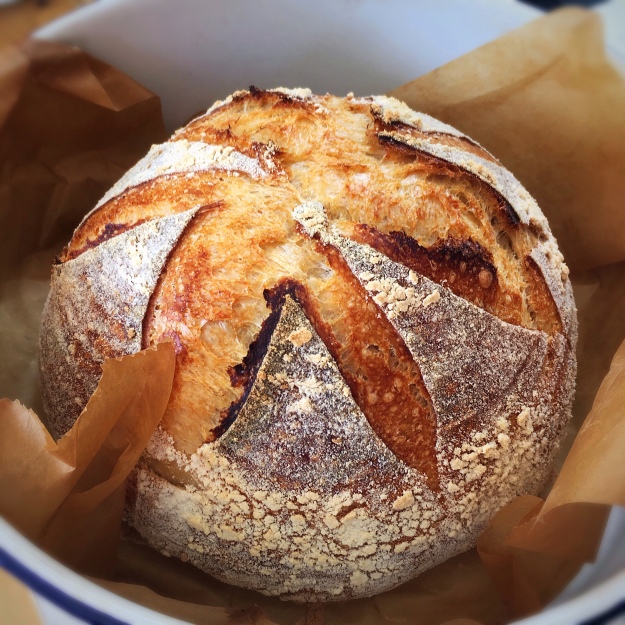


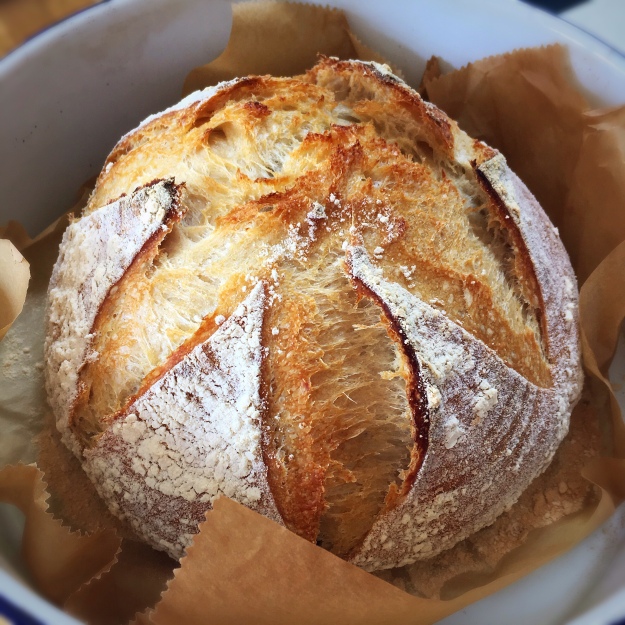
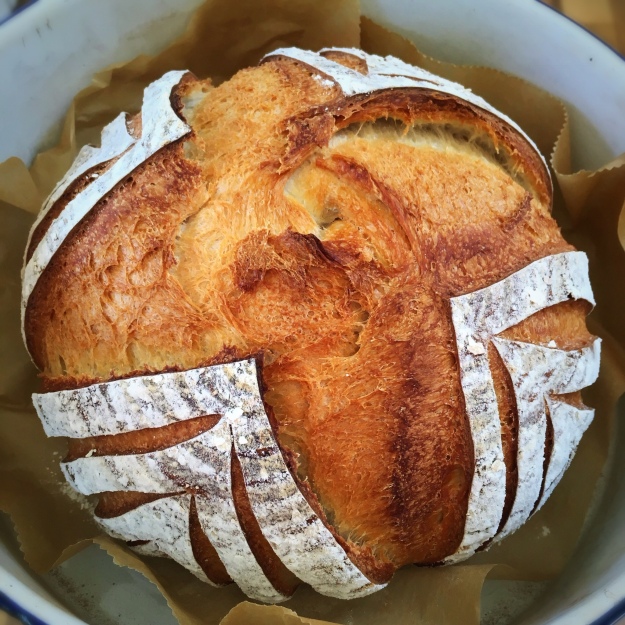

 Every year, around this time, I see so many posts on blogs and Instagram of people sharing their wild garlic creations. And each year I’m so envious!!! I’ve tried wild garlic once, having paid a fortune for it at a local ‘posh’ greengrocers, and I know it’s lovely, but I’ve never found any locally to be able to forage for myself…until this week!
Every year, around this time, I see so many posts on blogs and Instagram of people sharing their wild garlic creations. And each year I’m so envious!!! I’ve tried wild garlic once, having paid a fortune for it at a local ‘posh’ greengrocers, and I know it’s lovely, but I’ve never found any locally to be able to forage for myself…until this week! In this small wooded area, running along a path we walk up and down regularly, is an area of bountiful, gorgeous wild garlic.
In this small wooded area, running along a path we walk up and down regularly, is an area of bountiful, gorgeous wild garlic. Long red peppers, chargrilled, peeled and deseeded
Long red peppers, chargrilled, peeled and deseeded Wild garlic leaves and stalks, washed and dried
Wild garlic leaves and stalks, washed and dried
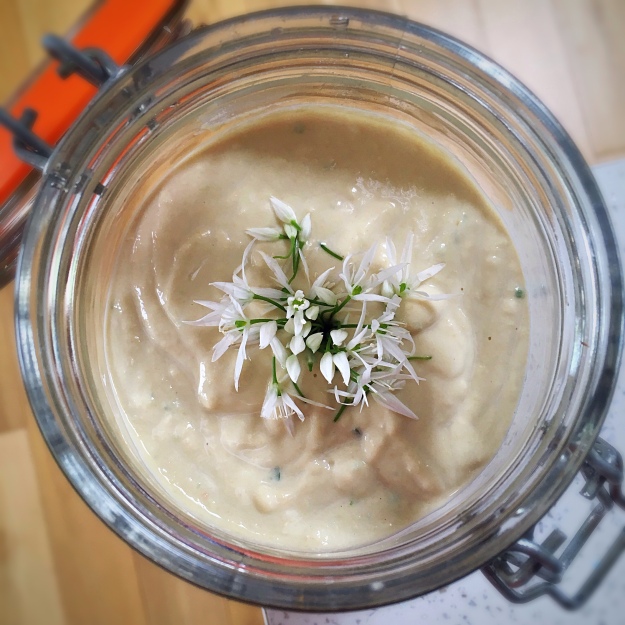 Make your standard homous recipe but leave out the garlic, and add some carefully picked wild garlic flowers at the end, stirring them in by hand. Leave it a day before eating it for the flavour to develop.
Make your standard homous recipe but leave out the garlic, and add some carefully picked wild garlic flowers at the end, stirring them in by hand. Leave it a day before eating it for the flavour to develop. Whizz up WG leaves and stalks, or just the stalks, or just the leaves, with your choice of cream cheese.
Whizz up WG leaves and stalks, or just the stalks, or just the leaves, with your choice of cream cheese. WG leaves and stalks chopped up with toasted pumpkin seeds, olive oil and lemon juice. Add your choice of cheese at will 🙂
WG leaves and stalks chopped up with toasted pumpkin seeds, olive oil and lemon juice. Add your choice of cheese at will 🙂 Wild garlic leaves and stems, washed and dried
Wild garlic leaves and stems, washed and dried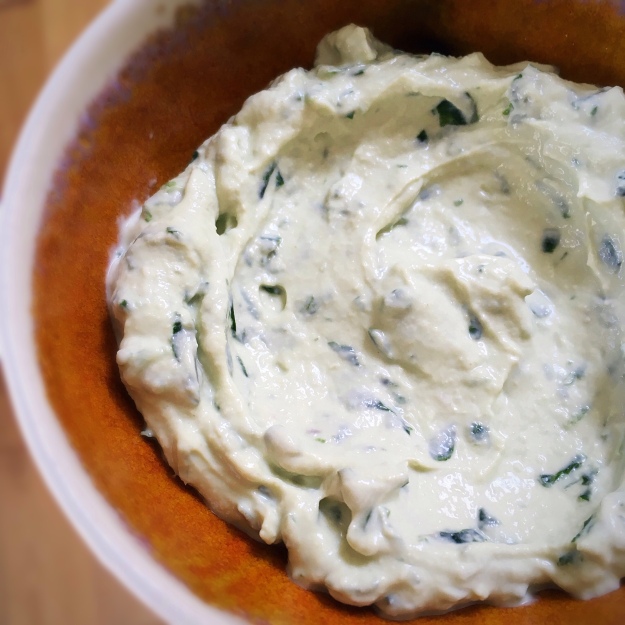 Blend WG leaves and stalks with tahini, yoghurt and lemon juice, and use at will like this, or add to other ingredients to create a dip, like below
Blend WG leaves and stalks with tahini, yoghurt and lemon juice, and use at will like this, or add to other ingredients to create a dip, like below
 Carrots cooked in olive oil with red onion and garlic and my Moroccan spice mix, whizzed up with some of the tahini and yogurt sauce from above.
Carrots cooked in olive oil with red onion and garlic and my Moroccan spice mix, whizzed up with some of the tahini and yogurt sauce from above. This was a mixture of some of the WG cream cheese mixed with the WG pesto, plus some boiled chunks of sweet potato and topped with wild garlic flowers.
This was a mixture of some of the WG cream cheese mixed with the WG pesto, plus some boiled chunks of sweet potato and topped with wild garlic flowers. A cook of the era knew exactly which part of the fire to use for which part of the meal. And at what time the heat was optimal for whatever they were cooking. The main heat of the fire was used for roasting and boiling, and the embers were used for long slow baking and simmering.
A cook of the era knew exactly which part of the fire to use for which part of the meal. And at what time the heat was optimal for whatever they were cooking. The main heat of the fire was used for roasting and boiling, and the embers were used for long slow baking and simmering.



 I LOVE leftovers; to me, leftovers, or foods eaten a day or two after cooking/preparing them, taste vastly better than they did on day one. Flavours develop to create something so good that I pretty much always plan for leftovers and extras…
I LOVE leftovers; to me, leftovers, or foods eaten a day or two after cooking/preparing them, taste vastly better than they did on day one. Flavours develop to create something so good that I pretty much always plan for leftovers and extras… These are what Petra sent me to try…lucky me! The two bottles that you can’t see the labels on are a ‘very hot hot sauce’ and a sweet chilli ginger sauce.
These are what Petra sent me to try…lucky me! The two bottles that you can’t see the labels on are a ‘very hot hot sauce’ and a sweet chilli ginger sauce.
 If you can try this stuff, you really should! Included in the ingredients are cobnuts which give the chutney a great texture. But the rest I played with today…
If you can try this stuff, you really should! Included in the ingredients are cobnuts which give the chutney a great texture. But the rest I played with today… So to today’s pimping…this was my lunch platter…
So to today’s pimping…this was my lunch platter…
 Leftover broccoli & cauliflower, blended with yoghurt, crunchy hazelnut butter & Petra’s sweet chilli ginger sauce which added great flavour to the vegetables.
Leftover broccoli & cauliflower, blended with yoghurt, crunchy hazelnut butter & Petra’s sweet chilli ginger sauce which added great flavour to the vegetables. My homemade garlic mayonnaise pimped with Petra’s very hot hot sauce – perfect pimping.
My homemade garlic mayonnaise pimped with Petra’s very hot hot sauce – perfect pimping. Leftover roasted carrots & red onions blended with tahini, yoghurt & lemon juice…so good, the lemon juice and roasted carrots always works well together.
Leftover roasted carrots & red onions blended with tahini, yoghurt & lemon juice…so good, the lemon juice and roasted carrots always works well together. Fresh flat leaf parsley & coriander chopped up with my pickled garlic, spring onions, ground cumin, Aleppo chilli flakes, salt, olive oil, my homemade apple cider vinegar & Petra’s caramelised Seville orange & chilli treacle – I often add pomegranate molasses to my salsa verde concoctions and this was a great alternative.
Fresh flat leaf parsley & coriander chopped up with my pickled garlic, spring onions, ground cumin, Aleppo chilli flakes, salt, olive oil, my homemade apple cider vinegar & Petra’s caramelised Seville orange & chilli treacle – I often add pomegranate molasses to my salsa verde concoctions and this was a great alternative. I drink a lot of green tea, and I’ve tried many many types and flavours, and my favourite is definitely ‘genmaicha’, a Japanese green tea with ‘genmai’ or roasted rice. The smell when you make the tea is gorgeous, and the rice adds a wonderful flavour to it. Some makes call it popcorn green tea because of how good it smells, a bit like popcorn.
I drink a lot of green tea, and I’ve tried many many types and flavours, and my favourite is definitely ‘genmaicha’, a Japanese green tea with ‘genmai’ or roasted rice. The smell when you make the tea is gorgeous, and the rice adds a wonderful flavour to it. Some makes call it popcorn green tea because of how good it smells, a bit like popcorn. In a perfect world you’d use proper Japanese rice, but failing that, I used what I had: weirdly, I used Spanish paella rice. The rice is white and plump and looks a bit like a Japanese rice so why not?
In a perfect world you’d use proper Japanese rice, but failing that, I used what I had: weirdly, I used Spanish paella rice. The rice is white and plump and looks a bit like a Japanese rice so why not? So, if you’ve never tried it before, how about making your own genmaicha?
So, if you’ve never tried it before, how about making your own genmaicha?
 A friend of ours has recently decided to stop eating meat. That sounds simple, but if you’ve always eaten meat, it’s not as simple as it sounds. If you’ve never really thought too hard about what you eat, it could be a complete shock to the system. Our friend is definitely finding that to be the case.
A friend of ours has recently decided to stop eating meat. That sounds simple, but if you’ve always eaten meat, it’s not as simple as it sounds. If you’ve never really thought too hard about what you eat, it could be a complete shock to the system. Our friend is definitely finding that to be the case.


 I had never heard of fantails before this week when I saw an image of an amazing little bread creation on Instagram; of course, I immediately searched it to see what it was and how to make my own and found this method using a muffin tin. I then made two batches two days running this week, of course, you wouldn’t expect anything else would you?! I made a cheesy version and a garlic butter version. They look so cool and are incredibly simple to make, and got a big thumbs up from my master bread taster 🙂
I had never heard of fantails before this week when I saw an image of an amazing little bread creation on Instagram; of course, I immediately searched it to see what it was and how to make my own and found this method using a muffin tin. I then made two batches two days running this week, of course, you wouldn’t expect anything else would you?! I made a cheesy version and a garlic butter version. They look so cool and are incredibly simple to make, and got a big thumbs up from my master bread taster 🙂 You can really use any basic bread recipe, it’s the assembly that’s the key, but I’ll let you know how I made my dough too. I only used a small quantity of dough, it can easily be doubled.
You can really use any basic bread recipe, it’s the assembly that’s the key, but I’ll let you know how I made my dough too. I only used a small quantity of dough, it can easily be doubled. Cover the whole muffin pan with a plastic bag and let the dough prove once more for up to an hour.
Cover the whole muffin pan with a plastic bag and let the dough prove once more for up to an hour.
 I brushed more garlic butter over mine whilst they were warm.
I brushed more garlic butter over mine whilst they were warm.
 They are lovely fresh from the oven, they were also good the next day, and reheated well in the oven for 5 mins.
They are lovely fresh from the oven, they were also good the next day, and reheated well in the oven for 5 mins. I hope everyone at this week’s
I hope everyone at this week’s  These are all apple cider vinegars. The photos below show them in the process of fermenting, you can see how the colour changes. The honey coloured liquid, in the middle above, started off as the cloudy yellow jars on the far right photo below..
These are all apple cider vinegars. The photos below show them in the process of fermenting, you can see how the colour changes. The honey coloured liquid, in the middle above, started off as the cloudy yellow jars on the far right photo below..
 *If mould appears it will be green; I had little green fluffy balls appear on a batch when I experimented with pears, and again when I tried using a pomegranate. If mould appears I’m afraid all is lost and you need to discard everything and start again.
*If mould appears it will be green; I had little green fluffy balls appear on a batch when I experimented with pears, and again when I tried using a pomegranate. If mould appears I’m afraid all is lost and you need to discard everything and start again. In December, I started a batch of orange vinegar, just oranges, water & honey…and it smelled AMAZING all over Christmas, perfect timing!
In December, I started a batch of orange vinegar, just oranges, water & honey…and it smelled AMAZING all over Christmas, perfect timing! This is what’s left from this jar about once it was drained…and it still smells amazing!
This is what’s left from this jar about once it was drained…and it still smells amazing! I am loving all of my various vinegars, after so much love, and time, I almost don’t want to use them, but that is why I made them after all…:)
I am loving all of my various vinegars, after so much love, and time, I almost don’t want to use them, but that is why I made them after all…:)





